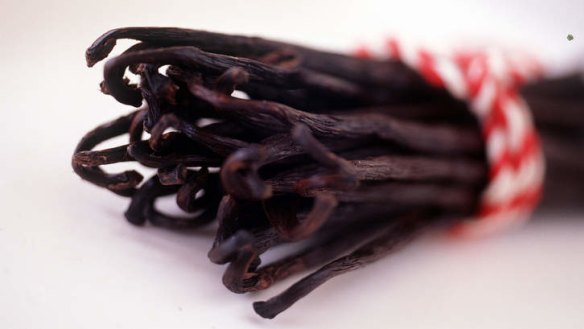Brain Food

A friend brought back a bag of vanilla beans from holidays for me. They are dry and brittle. Is there a way of reviving them to make them soft and pliable? M. Kohout
Bringing food into Australia! My goodness, I am surprised your friend didn't end up featuring on one of those thinly veiled racist, customs-based reality TV shows. Once picked, vanilla beans are fermented during which they lose much of their moisture. Enzymes and microscopic flora change the structure of the interior, developing the flavours and rendering the bean more shelf stable. Vanilla beans should be kept in a small airtight container to avoid over-drying, which leads to a loss of some of the vanilla's more volatile aromatic compounds. However, you can still use your dry beans. Slice the beans in half lengthways and add to the recipe as indicated. If just the seeds are required, soak a dry bean in a little warm water for an hour or two before scraping out with the tip of a knife. Alternatively, chop the vanilla beans up, place them in a jar and cover with good-quality vodka. Steep for six months to a year in a warm place and use as one would vanilla essence.
We have a beautiful crop of mint. What other meats besides lamb can we use it with? R. Dodson
It has been a very good year for mint for many, particularly earlier in the summer. Now the days are growing shorter, mint's growth is slowing down, preparing for its winter slumber. You'll notice the mint leaves growing slower and smaller, slightly thicker with a more determined ''mint'' aroma, the fleeting aroma of high summer almost a memory. Mint's aromatic compounds diffuse into acids such as vinegar, while sugar draws out the juices from the leaf. This is the basis for mint sauce and this classic sweet-and-sour mixture is a perfect foil for the fattiness of lamb. Also consider making a minty version of chimichurri sauce with cider vinegar, salt, spices, garlic and mint and serving with luscious slow-cooked pork. Perhaps make a marinade of mint, oil, garlic, oregano and an entire lemon, chopped and depipped, blended into a paste and smeared over chicken before barbecuing. But don't forget the vegies - try new potatoes with mint and butter, ripe tomatoes with salt, mint and sherry vinegar and have a look at some of the recipes at our website goodfood.com.au.
Why so many pear varieties and what do I do with them? G. Leigh
Although we see apples and pears in the supermarket year round, the fruit trees on which they grow have relatively short windows during which the fruit is ready to pick. Fruit growers maximise the possibility of profit by planting a range of different varieties that ripen at different times of the season, depending on the local climate. The season started in January with Williams' Bon Chretien, also known as Bartlett, and moved on to Red Sensation in February. Beurre Bosc and Winter Nelis are being harvested now. Corella, Anjou and Josephine will start shortly, followed by the old favourite Packham. Most pears are harvested when they are still firm enough to handle storage and transportation. Once harvested, they are cooled and often stored at just above freezing point in an atmosphere-controlled cool room, which slows down the enzymes that transform the starches in the cell walls into sugars, making the fruit softer. Most under-ripe pears are crisp and suitable in perhaps a salad of rocket and blue cheese, or chop with walnuts and celery to make a variation on the classic Caesar salad. Use the Beurre Bosc for poaching in wine and spices. Consider coring a Winter Nelis and baking filled with sultanas, brown sugar and some nuts and serving with cream.
Chilli or chili?
A few weeks ago, I corrected the misspelling of osso buco. I had it as osso bucco, which prompted a flurry of correspondence, such as this letter from P. Cohen. ''Since you graciously acknowledged the correct spelling of osso buco, kindly allow this old Californian to point out another all-too-common misspelling. Australians spell ''chili'' incorrectly. Invariably, even on products in our supermarkets, it is spelt ''chilli''. This is wrong. It's a Spanish word and, in Spanish, the double-l is pronounced as a ''y'', so ''chilli'' would come out something like ''chee-yee'', which is pretty much unpronounceable, not to mention incomprehensible.''
The best recipes from Australia's leading chefs straight to your inbox.
Sign up